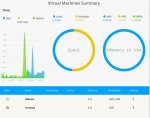F11.2 Betas have introduced a change in system behaviour that may not have been on people’s radar. It’s neither mentioned nor explained in the FreeNAS 11.2. Beta guide, but it was included in the Beta announcements on the iXsystems blog. ( See: https://www.ixsystems.com/blog/library/freenas-11-2-beta1/)
Virtual Machines are more crash-resistant. When a guest is started, the amount of available memory is checked and an initialization error will occur if there is insufficient system resources. When a guest is stopped, its resources are returned to the system.
You may have already seen an error message when trying to start a virtual machine in the Betas.
Until now, the end user could expect FreeNAS to install and run with sane defaults, one of which is the fixed value of the upper memory limit of the ARC, shown by
F11.2 attempts to balance the demand between the ARC and VM memory allocation by throttling the ARC’s upper memory limit. The bottom line is that the value of vfs.zfs.arc_max is no longer fixed if you run virtual machines.
So how is this working in practice and are there any pitfalls? This is where your feedback is needed. One obvious problem is that a VM configuration that runs on F11.1 may fail to meet the criteria of “sufficient systems resources” as defined by this new VM memory check. VMs that run under F11.1 may not run start under F11.2. In F11.2, is it also now possible that a single given VM my start in some circumstances, but not others?
This new “memory check” can be found in /usr/local/lib/python3.6/site-packages/middlewared/plugins/vm.py lines 790 to 860. Just how was that 35% factor arrived at? Hard coding such a value means it’s immutable as far as the end user is concerned. AFAIK , the code is the only place that defines the terms RNP, PRD and RPRD. These mystery labels appear on New UI Virtual Memory Summary page when you select "table" view,. along with two meaningless circular visual indicators. What the end user really needs is meaningful feedback about the storage consumed by VMs versus what is available and feedback about the memory allocated to VMs versus available memory.
REF: vm.py code at github
https://github.com/freenas/freenas/...60b/src/middlewared/middlewared/plugins/vm.py
Virtual Machines are more crash-resistant. When a guest is started, the amount of available memory is checked and an initialization error will occur if there is insufficient system resources. When a guest is stopped, its resources are returned to the system.
You may have already seen an error message when trying to start a virtual machine in the Betas.
Until now, the end user could expect FreeNAS to install and run with sane defaults, one of which is the fixed value of the upper memory limit of the ARC, shown by
sysctl vfs.zfs.arc_max. The end user was left to make sensible choices about the memory allocated to any virtual machines while the operating system managed the competing memory demands of the ARC, running VMs, etc. Overprovision the VM memory allocation and VM performance could degrade as the ARC grows with i/o activity. Swapping can occur as available RAM is exhausted and the whole system grinds to a halt.F11.2 attempts to balance the demand between the ARC and VM memory allocation by throttling the ARC’s upper memory limit. The bottom line is that the value of vfs.zfs.arc_max is no longer fixed if you run virtual machines.
So how is this working in practice and are there any pitfalls? This is where your feedback is needed. One obvious problem is that a VM configuration that runs on F11.1 may fail to meet the criteria of “sufficient systems resources” as defined by this new VM memory check. VMs that run under F11.1 may not run start under F11.2. In F11.2, is it also now possible that a single given VM my start in some circumstances, but not others?
This new “memory check” can be found in /usr/local/lib/python3.6/site-packages/middlewared/plugins/vm.py lines 790 to 860. Just how was that 35% factor arrived at? Hard coding such a value means it’s immutable as far as the end user is concerned. AFAIK , the code is the only place that defines the terms RNP, PRD and RPRD. These mystery labels appear on New UI Virtual Memory Summary page when you select "table" view,. along with two meaningless circular visual indicators. What the end user really needs is meaningful feedback about the storage consumed by VMs versus what is available and feedback about the memory allocated to VMs versus available memory.
REF: vm.py code at github
https://github.com/freenas/freenas/...60b/src/middlewared/middlewared/plugins/vm.py
Attachments
Last edited:


